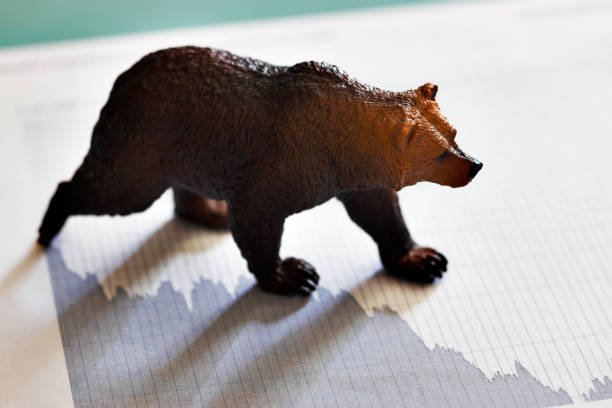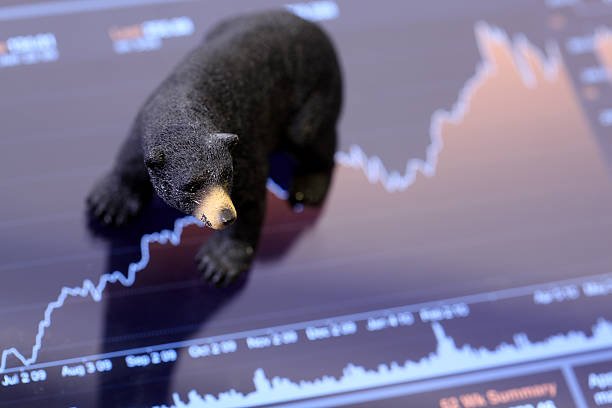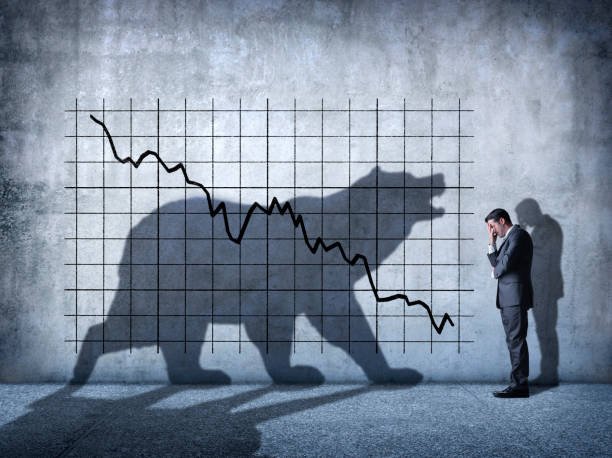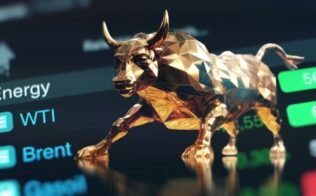What is a Bear Market?
When a market experiences prolonged price declines, it is called a bear market. This bear market generally illustrates a situation where securities prices fall 20% or more from present-day highs amongst wide-ranging despondency and are often accompanied by Negative Investment Sentiment.
Bear market very frequently corresponds with the declines that occur in an overall market or the indices, such as the S&P 500 but, on the contrary, also be linked with individual securities and commodities.
Bear market, on the other hand, can also be related to a Recession, which is an economic downturn.
In reference to a bear market, the Recession plays a very important role in recognizing a bear market. As a stock market bear generally produces negative perceptions regarding investments, investors habitually would rather hoard their money for fear of incurring losses.

Investors are usually adept and make themselves familiar with the ways the stock market works to build up a way of thinking that majorly refers to the fall in the stock market prices in the future in this bearish state of affairs, which later aggravates the fall rate of the already fallen stock prices.
To understand what is a bear market, we can classify it as long-term or cyclical. The former can last up to several weeks or a few months, while the latter can go up to a couple of years or sometimes even decades.
Read: What Is The Stock Market And How It Works?
To inverse ETFs, short-selling or the policies of selling borrowed securities and then purchasing those securities again at a lower price pose possibilities where investors can profit in the course of a bear market as the price falls.
Usually, stock prices indicate the succeeding possibilities of profits and cash flow experiences by companies. Prices of stocks decline as these possibilities are not matched, and the growth prospects decline.
Types of Bear Market
There are two major types of a bear market:
1. Cyclical Bear Market
This type of bear market emerges due to business cycle fluctuations in a particular economy which generally range between 7 to 10 years. Markets usually adjust after an extended time of reverberation and are then characterized by extensive growth rates illustrated by all the major sectors of the economy.
A cyclical decline in stock prices normally occurs in a country, and the declining stock prices automatically adjust to retrieve a positive perspective with respect to investments in the stock market in a short period. A good example of this type of bear market would be the 2008 Recession.
2. Secular Bear Market
This type of bear market describes long-term market conditions that usually occur due to domestic policies. Such secular trends lead to a bearish perspective that can also have long-lasting effects on an economy which is usually seen as a drawback by investors and prevents them from investing in heavy investment ventures to an extent.
When there is an increase in the interest in zero-risk instruments like treasury bills or bonds, an increase in investments that include these instruments by the investors is also seen.
This promotes a decrease in the total speculative demand for stock market instruments, generating a bearish attitude in the stock market.

What causes Bear Market?
To get a clear picture of the causes of the bearish market, we need to go back to what is a bear market. When investors usually turn their back against risk, than to seek it. This is another perspective on the bear market and helps us understand the causes.
The causes of a bearish market, in collective thought, appear to show a range of variations. For example, the pandemic due to covid-19 or public health crisis, war, sluggish economy, geopolitical crisis, poor economic data, fiscal policies, etc.
There are a few factors that cause the occurrence of the bear market:
1. The Unanticipated Fluctuations
Fluctuations can come about on account of socio-economic turmoil in a particular country. As political commitments and conclusions undeniably influence the performance of large companies. Operating in an economy, a difference in the investments is also affected.
2. Global Mentality
With the increase in interdependence among countries worldwide, even the slightest fluctuation in a substantially major economy is prone to give out a chain reaction in a domestic economy.
For example, we can consider the countries America and China. They are two large and major economies in the world. These enormous economies brought about uncertainty among the Investors from the Indian continent and led to the decline in the sense points as well.
This impactful relationship between the internationally overpowering economies can create a disturbance in the Indian economy and also in the import and export revenues. With respect to this, a considerable variation is also seen in the profitability of the domestic industries.
3. World Recession
What does a bearish market mean? In this context, the global bearish mindset is meant to provoke a recession worldwide. This creates a bear market in all the prime stock markets that operate all over the world.
The individual share prices on the stock exchanges also decline as companies develop the tendency to underperform. As they owe to the reduced market demand for their products.
These kinds of fluctuations in the stock market can exert an influence on small-cap, mid-cap, and large-cap companies. According to which a more distinctive consequence is perceived in the companies that are small-cap and mid-cap, as they owe to their high degree of volatility.
When a business cycle has repetitive movements, it causes a Recession in any economy. This is identified and distinguished by a gradual decrease in the price level overall. This also comprises the downfall in the average stock prices that is an outcome of reduced demand. Which reduces the value of benchmark indices in a country.
The first hint of an impending recession is a crucial value drop in significant indices correlated to a country’s stock exchange at the leading edge.

A Historical Perspective on What is Bear Market.
1. The Great Depression in 1929
The Great Depression is said to the most extended depression in history. It is reported that this great depression was primarily caused by a bearish market that was tenacious for more than 10 years. The years that came before 1929 were said to have seen a hypothesizing drive.
This encouraged individuals to buy over-inflated assets at prices higher than their usual and absolute value. Such an increase in prices forced companies to shift to excess production. Which instantly led to excess supply in the market.
This initiated a significant fall in the average price level. Which later became a prime reason for deflation and caused a penetration in the stock market.
24th October 1929, or the Black Thursday, marked the beginning of the bear market. As this was when the stock crash had occurred. And a massive volume of sales of almost 12.9 million shares was recorded.
2. 2008 Recession
A gradual stagnation in the global finances was notarized as it followed the subprime mortgage crisis in America. Which was later followed by the decline in one of the most important and biggest financial institutions in the world. Lehman Brothers Holdings Inc. was now owing greatly to Globalization.
The world had indeed experienced the consequences of this Recession. Indian investors took forward a bearish investment pattern. And they preferred to hold back the money and deposit it in risk-free tools.
Must Read: How to Invest in the US Stock Market from India?
Different Stages of a Bear Market
There are four stages to a bear market:
Stage 1: Recognition
High prices and positive investment sentiment characterize this stage. In this phase of a bear market, investors usually tend to ignore the primary outbreak of a bear market as it is mistaken for regular day-to-day fluctuations.
By the end of this phase, a few investors recognize that a bear market is approaching, and they begin to sell their securities.
Stage 2: Panic
In this bear market stage, prices are prone to decline acutely, and investors capitulate. With a decline in the trading volumes, economic indices may begin to lean toward a worse economy. Investor sentiment also begins to decline gradually.
Stage 3: Stabilization
By the time this stage of a bear market occurs, panic selling has begun. This indicates that investors must understand the major reasons for the decline in the price. The stabilization stage is very volatile, turbulent and generally lasts much longer than other stages of a bear market. There may be rallies that tend to reverse as the market speculators enter.
Stage 4: Anticipation
In this bear market stage, prices are starting to settle down and find a bottom. Low estimations and good news begin to captivate many investors to buy more securities.

Market Correction vs. Bear Market
A bear market means to depict a fall in the market prices by more than 20%; the Market correction indicates the automated adjustment of the rising stock prices followed by a bull market.
Market corrections are usually followed by a trend in which the rising stock prices make way for the prices to rise higher and allow a different investment pattern. This is a classic indicator of a developing economy. A well-performing stock market generates a positive effect on the GDP of that country as well.
A market correction is very often wrongly used as a synonym for what is a bear market. The major difference between a bear market and a market correction is the level of the fall in price and the time period.
A bear market cannot be mistaken for a correction. Because it is a short-term event that takes two months or less. Market corrections usually provide value investors a good time. So that they can find an entry point into the stock markets, while bear markets provide very few or no entry points.
This kind of barrier is created mostly because it close to impossible to figure when the bear market has hit bottom. Trying to retrieve the losses that have occurred could be ascending struggle. Unless the investors are short sellers or unless they use different schemes in order to make profits in this declining market.
What is Short Selling in the Bear Market?
Short selling tends to adhere to the bear market meaning. This method helps investors make profits in a bear market. This technique also comprehends the selling of already borrowed shares and purchasing these shares back at a really low rate.
This kind of trading is very risky, and if it does not work out well, it has high possibilities that the investor may experience massive losses. A short seller must have borrowed some shares from a broker prior to the placing of a short sell order.
The gains of the short seller, as well as the loss amount, is called the difference between the price. Where the shares are sold, and the price where they were bought back, and is also known as Covered.
Consequences of The Bear Market
A bear market usually represents a decline in an economy, with an increase in investor pessimism and recessionary trends. The total amount of investments that are embarked upon declines significantly in these events. And simultaneously owes to the downtrend of the aggregated demand.
In most parts, businesses encounter a momentary crush, which decreases the end output.
This results in unemployment issues and a decline in the overall price level that also causes deflation. This indicates a poor performance in the stock market, which also depicts a recession.

How to Invest in a Bear Market?
The very important point that needs to be given light to in this context is the varying prices of the stocks in the market. The prices usually fluctuate very fast as comprehend the changes in a business cycle.
This, in turn, results in the purchasing of securities at a declined price. Which can also be sold again in the future when the market has redeemed from its bearish state. This also aids the investors in recognizing the substantial capital profits that are made in the process.
Another important point here is that immediate sales of the securities can instantly lead to substantial losses for the investors, but retaining these securities can be profited from.
When we look at this as a long-term project, when prices begin to adhere to the bullish market or the increasing prices of the stocks, major operating companies show a significant increase in their profits. This also promises significant dividend payout Can Investors Do in a Bear Market?
Also Read: STOCK MARKET TERMINOLOGY FOR BEGINNERS
When we talk about investing in it, we come back to what a bearish market mean. It signifies that the decline in the stock prices can either be just 20% or higher. And this can be comparatively trouble-free with respect to whether an investor has been appropriately diversified and whether he can handle it in terms of a long-term plan.
Berkshire Hathaway’s CEO, Warren Buffett, has been a prominent and important investor to learn from. He teaches us how to invest like someone with a lot of securities at all market seasons, during times of recession, or even in times of increased volatility. This expert investor is said to have a compounded capital for over 50 years, which is at more than 20% annually.
As investors, we must develop certain schemes to coup. And those that imitate how a millionaire would invest in a bear market. These schemes, in turn, help us to keep up the consistency. As well as the stability in our strategies of investing. A consistent periodic cash flow. Such investors must choose to hold their investments in the succeeding stock market bear in the future to promote wealth accumulation.
One response to “Understanding Bear Market: Types, Causes, and Consequences”
Leave a Reply
Recent blog
Course
- Unlocking the Mysteries of Bull Markets: A Comprehensive Guide
- Understanding Blue Chip Stocks: Definition, Examples, and Investment Strategies
- Understanding Volatility: What Is Volatility in the Stock Market?
- What is SEBI: Role, Structure, and Powers
- Understanding Demat Market: Features, Benefits, and Types of Demat Accounts






[…] Must Read: Understanding Bear Market: Types, Causes, and Consequences […]